Five native edible plants for your garden | Homegrown Goodness
Local gardening expert and All The Dirt podcast host Deryn Thorpe explains how easy it is to grow delicious native edible plants at your place.
Whether you’re a home gardening novice or a seasoned green thumb, why not enjoy the thrill of growing truly local flavours and plant some bush tucker in your backyard or veggie patch?
Bush foods have sustained generations of Aboriginal and Torres Strait Islander people for thousands of years but have become increasingly popular with home gardeners who enjoy the experience of growing something a little unusual.
Most edible plants we grow in our garden originated overseas and it’s only been in recent times that a range of native ‘bush tucker’ plants bearing flavoursome fruits, nuts, seeds and leaves have become available for sale.
While these plants come from a wide range of Australian climates, your local garden centre will sell varieties suited to your weather and soil conditions and a wide range that grow well in pots.
It also means you can serve up native-inspired cuisine to delight your family and guests or inspire fresh dinner table conversation.
Leading the way with garden bush tucker
Local expert Mark Tucek is the grower behind Tucker Bush, Australia’s most extensive range of native edible plants.
“When I started Tucker Bush five years ago, there was only a small interest in native edibles,” Mark said.
“Adventurous chefs led with ‘foraging’ to differentiate themselves in the market and because fresh produce supply was limited. Much of the fresh native ingredients came out of South Australia via Melbourne, so the food miles were terrible.”
Mark discourages foraging, mainly as he believes many white Australians don’t have the generational knowledge, history and affinity for the land like First Nations people.
“I could see chefs starting to do some damage in spots along the Swan River and believed picking from garden-grown plants was a more sustainable option,” he said.
“I sourced a range of native edible plants from all over Australia and supported it with a website with information about bush tucker.”
Mark also laments the fact modern Australia has labelled many native herbs with common names associated with familiar exotic herbs, even though indigenous herbs have different flavours and complex tastes.
Feeling inspired? Get growing
While the availability of Australian native bush tucker plants depends on seasonality, there’s always something on offer in your local garden centre or nursery.
These five native edibles are perfect for getting started:
River mint (Mentha australis)
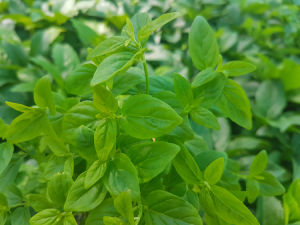 A small-leaved relative of peppermint and spearmint, which has a similar minty flavour.
A small-leaved relative of peppermint and spearmint, which has a similar minty flavour.
All mints are invasive in the ground so grow best for a pot in shady areas with plenty of moisture.
To harvest, pluck leaves from the plant or prune off stalks, as the plant needs regular pruning to keep it tidy.
Plants grow to 30cm high and 100cm wide but can expand much further if allowed to run wild.
Lemon myrtle (Backhousia citriodora)
Leaves from this big shrub or small tree have a strong citrus fragrance and flavour, which suits many savoury and sweet dishes.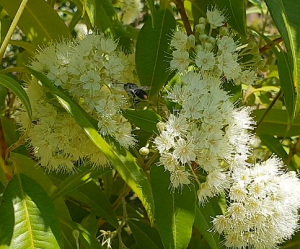
Pluck the glossy oval leaves straight from the tree, removing no more than one-third at any time.
Expect fragrant, creamy flowers in autumn and when planted in a warm, sunny or shaded spot sheltered from frost and cold winds.
Grow in well-drained soil as a big shrub or ornamental shade tree, but keep plants well-watered throughout the year.
Lemon myrtle can grow to 3m tall or up to 8m, though smaller in pots.
Native thyme (Prostanthera incisa)
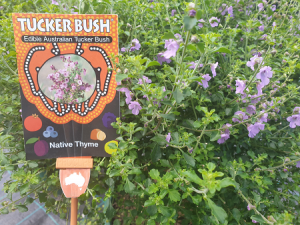 Another native mint with flavours of earthy pepper, which gives off a minty aroma when crushed or rubbed.
Another native mint with flavours of earthy pepper, which gives off a minty aroma when crushed or rubbed.
The complex flavour teams well with chicken, fish, emu, kangaroo and lamb dishes – or simply steep in hot water for delicious herbal tea.
To harvest, pluck fresh leaves off the growing plant or prune whole stalks.
This species prefers warmth and moisture, growing best in well-draining soil and full sun or part shade. Water generously in summer.
Plants grow fast to 2m tall and 2m wide, with small purple flowers in spring. It can be kept in a pot if pruned regularly.
Blue lilly pilly (Syzygium oleosum)
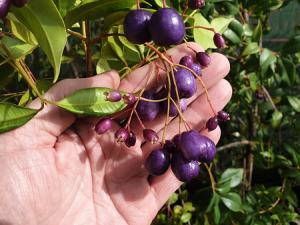 A relative newcomer to WA, the blue lilly pilly is an ornamental tree with palatable blue-purple berries that are crunchy and mildly sweet with hints of ginger and lavender.
A relative newcomer to WA, the blue lilly pilly is an ornamental tree with palatable blue-purple berries that are crunchy and mildly sweet with hints of ginger and lavender.
Clusters of berries start out red and develop blue hues as they ripen and can be eaten fresh or made into jams, wine and sweets.
Plants have beautiful, creamy-white flowers from spring to winter, which develop into the berries.
Grow them in full sun or part shade in rich, well-drained soils that are kept continually moist.
Blue lilly pilly trees can reach 7m in a garden setting but may be kept as a shrub or in a big pot with adequate pruning.
Round baby pigface (Disphyma crassifolium ssp. Clavellatum)
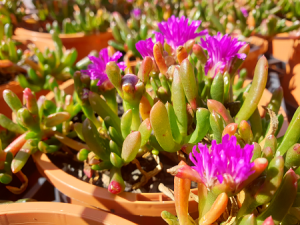 A saline-tolerant succulent with edible leaves and sweet fruits, this hardy plant grows in coastal areas and inland saline soils in all southern Australian states.
A saline-tolerant succulent with edible leaves and sweet fruits, this hardy plant grows in coastal areas and inland saline soils in all southern Australian states.
Round baby pigface offers juicy leaves that can be harvested year-round and traditionally served cooked as an accompaniment to game meat or to add a refreshing crunch to salads.
Plants bear pink to purple flowers year-round in good conditions and develop into small, berry-sized fruits that can be eaten fresh.
They’ll tolerate frost, drought and salinity and grow in all soils – but prefer freely draining soil in a full-sun or partly shaded position.
The perennial ground-cover shrub grows 2cm–30cm high with a 1–2m spread.
Turning your garden into good tucker
There’s so much satisfaction in growing fruit and vegetables at home when putting them to good use in the kitchen.
Use your new-found knowledge about growing native edible plants to inspire new ways to incorporate them into home recipes from the Kleenheat Kitchen.
Need tips for setting up some homegrown goodness in your backyard? Read up on handy tips for setting up your veggie patch for success.
About Tucker Bush
Bush food has sustained generations of Aboriginal peoples for centuries, and today represents a rich and vibrant history in the culture of this land.
The Tucker Bush range aims to introduce a truly local flavour to the modern suburban home, working with communities with unique stories to share.
About All The Dirt
Deryn Thorpe and Steve Wood present the popular gardening podcast, All The Dirt, sharing their local experience and trade tips.
Deryn’s an award-winning garden journalist passionate about creating beautiful and healthy home gardens, while Steve is a local horticulturalist with over 40 years’ experience in wholesale nursery production.